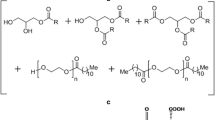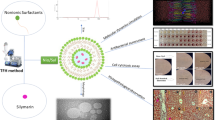Abstract
Purpose
Methotrexate is one of the widely used agents to treat various solid tumors, although its usage brings some challenges because of its poor bioavailability and/or dose-dependent side effects. Increasing the solubility, permeability, and consequently bioavailability in company with minimizing side effects are always desired to formulate such these drugs. In this paper, we concentrated on formulation parameters of methotrexate-loaded niosomes, in an attempt to facilitate its solubility.
Methods
Various formulation parameters were utilized, including surfactant types, the amount of membrane additives, and types of hydrating agent. Methotrexate-loaded niosomes were fully characterized. The cell viability and hemolysis assay were evaluated. The effects of developed formulation on cellular interaction, growing, and micronuclei assay were also investigated.
Results
Methotrexate (MTX)-loaded niosomes were produced in small particle size (241.3 ± 65.7 nm) with high uniformity using sodium hydroxide as hydrating solution. Their entrapment efficiency was 59.5 ± 3.0% and the release completed in 6 h. The incorporation of methotrexate into niosomes was confirmed, and their higher efficiency on cell viability was presented. MTX-loaded niosomes were found safe and acceptable for parenteral administration. The number of apoptotic and dead cells were increased significantly in all types of cells treated with niosomes. The apoptosis-mediated cell death was triggered by produced niosomes.
Conclusion
This study suggests that MTX-loaded niosomes formulated with sodium hydroxide provided a significant improvement in niosome characteristics with the help of solubility enhancement strategies. The cellular assessments proved its potential efficacy. It is concluded that these promising results should be promoted in further studies.









Similar content being viewed by others
References
Jo Y-K, Park MH, Choi H, Lee H, Park J-M, Sim JJ, et al. Enhancement of the antitumor effect of methotrexate on colorectal cancer cells via lactate calcium salt targeting methionine metabolism. Nutr Cancer United States. 2017;69:663–73.
Gonen N, Assaraf YG. Antifolates in cancer therapy: Structure, activity and mechanisms of drug resistance. Drug Resist Updat. 2012;15:183–210. Available from: http://www.sciencedirect.com/science/article/pii/S1368764612000489.
Wei C-W, Yu Y-L, Chen Y-H, Hung Y-T, Yiang G-T. Anticancer effects of methotrexate in combination with α-tocopherol and α-tocopherol succinate on triple-negative breast cancer. Oncol Rep Greece. 2019;41:2060–6.
Van Roon EN, Van de Laar M. Methotrexate bioavailability. 2010.
Khan ZA, Tripathi R, Mishra B. Methotrexate: a detailed review on drug delivery and clinical aspects. Expert Opin Drug Deliv England. 2012;9:151–69.
Hansen J, Kreilgård B, Nielsen O, Veje J. Kinetics of degradation of methotrexate in aqueous solution. Int J Pharm. 1983;16:141–52. Available from: http://www.sciencedirect.com/science/article/pii/0378517383900510.
Jadhav P, Bothiraja C, Pawar A. Methotrexate-loaded nanomixed micelles: formulation, characterization, bioavailability, safety, and in vitro anticancer study. J Pharm Innov. 2018;13:213–25. Available from: https://doi.org/10.1007/s12247-018-9314-4.
Kapoor K, Nagaich U. Development and characterization of sustained release methotrexate loaded cubosomes for topical delivery in rheumatoid arthritis. Int J Appl Pharm. 2020;33–9.
Rizzo LY, Theek B, Storm G, Kiessling F, Lammers T. Recent progress in nanomedicine: therapeutic, diagnostic and theranostic applications. Curr Opin Biotechnol. 2013;24:1159–66.
Malam Y, Loizidou M, Seifalian AM. Liposomes and nanoparticles: nanosized vehicles for drug delivery in cancer. Trends Pharmacol Sci England. 2009;30:592–9.
Din FU, Aman W, Ullah I, Qureshi OS, Mustapha O, Shafique S, et al. Effective use of nanocarriers as drug delivery systems for the treatment of selected tumors. Int J Nanomedicine. 2017;12:7291–309.
De Jong WH, Borm PJA. Drug delivery and nanoparticles:applications and hazards. Int J Nanomedicine. 2008;3:133–49.
Esim O, Hascicek C. Lipid-coated nanosized drug delivery systems for an effective cancer therapy. Curr Drug Deliv. 2020.
Dahan A, Miller JM. The solubility-permeability interplay and its implications in formulation design and development for poorly soluble drugs. AAPS J. 2012;14:244–51.
Gülsün İnal T, Akdag Caylı Y, Izat N, ÖNER L, Sahin S. Effect of particle size and surfactant on the solubility, permeability and dissolution characteristics of deferasirox. J Res Pharm. 2019;23:851–9.
Duan X, Yang X, Li C, Song L. Highly water-soluble methotrexate-polyethyleneglycol-rhodamine prodrug micelle for high tumor inhibition activity. AAPS PharmSciTech. 2019;20:245. Available from: https://doi.org/10.1208/s12249-019-1462-4.
Zeb A, Qureshi OS, Kim H-S, Cha J-H, Kim H-S, Kim J-K. Improved skin permeation of methotrexate via nanosized ultradeformable liposomes. Int J Nanomedicine. Dove Medical Press; 2016;11:3813–24. Available from: https://pubmed.ncbi.nlm.nih.gov/27540293.
Sadarani B, Majumdar A, Paradkar S, Mathur A, Sachdev S, Mohanty B, et al. Enhanced skin permeation of methotrexate from penetration enhancer containing vesicles: In vitro optimization and in vivo evaluation. Biomed Pharmacother. France; 2019;114:108770.
Zidan AS, Mokhtar Ibrahim M, El MNA. Optimization of methotrexate loaded niosomes by Box-Behnken design: an understanding of solvent effect and formulation variability. Drug Dev Ind Pharm England. 2017;43:1450–9.
Abdelbary AA, AbouGhaly MHH. Design and optimization of topical methotrexate loaded niosomes for enhanced management of psoriasis: application of Box-Behnken design, in-vitro evaluation and in-vivo skin deposition study. Int J Pharm Netherlands. 2015;485:235–43.
Khan DH, Bashir S, Khan MI, Figueiredo P, Santos HA, Peltonen L. Formulation optimization and in vitro characterization of rifampicin and ceftriaxone dual drug loaded niosomes with high energy probe sonication technique. J Drug Deliv Sci Technol. 2020;58:101763. Available from: http://www.sciencedirect.com/science/article/pii/S177322472030441X.
Ertekin ZC, Bayindir ZS, Yuksel N. Stability studies on piroxicam encapsulated niosomes. Curr Drug Deliv United Arab Emirates. 2015;12:192–9.
Ge X, Wei M, He S, Yuan W-E. Advances of non-ionic surfactant vesicles (niosomes) and their application in drug delivery. Pharmaceutics. MDPI; 2019;11:55. Available from: https://pubmed.ncbi.nlm.nih.gov/30700021
Ag Seleci D, Seleci M, Walter J-G, Stahl F, Scheper T. Niosomes as nanoparticular drug carriers: fundamentals and recent applications. Liu L, editor. J Nanomater. Hindawi Publishing Corporation; 2016;2016:7372306. Available from: https://doi.org/10.1155/2016/7372306.
Kazi KM, Mandal AS, Biswas N, Guha A, Chatterjee S, Behera M, et al. Niosome: a future of targeted drug delivery systems. J Adv Pharm Technol Res. 2010;1:374–80.
Sezgin-Bayindir Z, Antep MN, Yuksel N. Development and characterization of mixed niosomes for oral delivery using candesartan cilexetil as a model poorly water-soluble drug. AAPS PharmSciTech. 2015;16:108–17.
Bayindir ZS, Yuksel N. Characterization of niosomes prepared with various nonionic surfactants for paclitaxel oral delivery. J Pharm Sci United States. 2010;99:2049–60.
Tavano L, Muzzalupo R, Trombino S, Cassano R, Pingitore A, Picci N. Effect of formulations variables on the in vitro percutaneous permeation of Sodium Diclofenac from new vesicular systems obtained from Pluronic triblock copolymers. Colloids Surf B Biointerfaces Netherlands. 2010;79:227–34.
Wallace SJ, Li J, Nation RL, Boyd BJ. Drug release from nanomedicines: selection of appropriate encapsulation and release methodology. Drug Deliv Transl Res. 2012/03/03. 2012;2:284–92. Available from: https://pubmed.ncbi.nlm.nih.gov/23110256.
Muzzalupo R, Tavano L, Cassano R, Trombino S, Ferrarelli T, Picci N. A new approach for the evaluation of niosomes as effective transdermal drug delivery systems. Eur J Pharm Biopharm. 2011;79:28–35. Available from: http://www.sciencedirect.com/science/article/pii/S0939641111000464.
Elmowafy E, El-Derany MO, Biondo F, Tiboni M, Casettari L. Soliman ME. Quercetin Loaded Monolaurate Sugar Esters-Based Niosomes: Sustained release and mutual antioxidant-hepatoprotective interplay. Pharmaceutics; 2020. p. 12.
Rathee J, Kanwar R, Kaushik D, Salunke DB, Mehta SK. Niosomes as efficient drug delivery modules for encapsulation of Toll-like receptor 7 agonists and IDO-inhibitor. Appl Surf Sci. 2020;505:144078. Available from: http://www.sciencedirect.com/science/article/pii/S0169433219328946.
Mohamad Saimi NI, Salim N, Ahmad N, Abdulmalek E, Abdul Rahman MB. Aerosolized niosome formulation containing gemcitabine and cisplatin for lung cancer treatment: optimization. Pharm: characterization and in vitro evaluation; 2021.
Pham CTN, Thomas DG, Beiser J, Mitchell LM, Huang JL, Senpan A, et al. Application of a hemolysis assay for analysis of complement activation by perfluorocarbon nanoparticles. Nanomedicine. 2014;10:651–60.
Cevik O, Turut FA, Acidereli H, Yildirim S. Cyclosporine-A induces apoptosis in human prostate cancer cells PC3 and DU145 via downregulation of COX-2 and upregulation of TGFβ. Turkish J Biochem. Berlin, Boston: De Gruyter; 2018;44:47–54. Available from: https://www.degruyter.com/view/journals/tjb/44/1/article-p47.xml.
Abdelbary G, El-Gendy N. Niosome-encapsulated gentamicin for ophthalmic controlled delivery. AAPS PharmSciTech. 2008/06/18. Springer US; 2008;9:740–7. Available from: https://pubmed.ncbi.nlm.nih.gov/18563578.
Akbari V, Abedi D, Pardakhty A, Sadeghi-Aliabadi H. Release studies on ciprofloxacin loaded non-ionic surfactant vesicles. Avicenna J Med Biotechnol. 2015;7:69–75.
Manosroi A, Wongtrakul P, Manosroi J, Sakai H, Sugawara F, Yuasa M, et al. Characterization of vesicles prepared with various non-ionic surfactants mixed with cholesterol. Colloids Surfaces B Biointerfaces. 2003;30:129–38. Available from: http://www.sciencedirect.com/science/article/pii/S0927776503000808.
García-Manrique P, Machado ND, Fernández MA, Blanco-López MC, Matos M, Gutiérrez G. Effect of drug molecular weight on niosomes size and encapsulation efficiency. Colloids Surfaces B Biointerfaces. 2020;186:110711. Available from: http://www.sciencedirect.com/science/article/pii/S0927776519308550.
Shahiwala A, Misra A. Studies in topical application of niosomally entrapped Nimesulide. J Pharm Pharm Sci a Publ Can Soc Pharm Sci Soc Can des Sci Pharm. Canada; 2002;5:220–5.
Kumar GP, Rajeshwarrao P. Nonionic surfactant vesicular systems for effective drug delivery—an overview. Acta Pharm Sin B. 2011;1:208–19. Available from: http://www.sciencedirect.com/science/article/pii/S2211383511000815.
dos Santos AM, Carvalho FC, Teixeira DA, Azevedo DL, de Barros WM, Gremião MPD. Computational and experimental approaches for development of methotrexate nanosuspensions by bottom-up nanoprecipitation. Int J Pharm. 2017;524:330–8. Available from: http://www.sciencedirect.com/science/article/pii/S0378517317302570.
Biswas S, Torchilin VP. Nanopreparations for organelle-specific delivery in cancer. Adv Drug Deliv Rev. 2014;66:26–41. Available from: http://www.sciencedirect.com/science/article/pii/S0169409X13002639.
Demirbolat GM, Altintas L, Yilmaz S, Degim IT. Development of Orally Applicable, Combinatorial Drug–Loaded Nanoparticles for the Treatment of Fibrosarcoma. J Pharm Sci. 2018;107:1398–407. Available from: http://www.sciencedirect.com/science/article/pii/S0022354918300066.
Jain A, Ran Y, Yalkowsky SH. Effect of pH-sodium lauryl sulfate combination on solubilization of PG-300995 (an Anti-HIV agent): A technical note. AAPS PharmSciTech. 2004;5:65–7. Available from: https://doi.org/10.1208/pt050345.
Escudero I, Geanta RM, Ruiz MO, Benito JM. Formulation and characterization of Tween 80/cholestherol niosomes modified with tri-n-octylmethylammonium chloride (TOMAC) for carboxylic acids entrapment. Colloids Surfaces A Physicochem Eng Asp. 2014;461:167–77. Available from: http://www.sciencedirect.com/science/article/pii/S0927775714006566.
Schmidts T, Dobler D, Nissing C, Runkel F. Influence of hydrophilic surfactants on the properties of multiple W/O/W emulsions. J Colloid Interface Sci United States. 2009;338:184–92.
Danaei M, Dehghankhold M, Ataei S, Hasanzadeh Davarani F, Javanmard R, Dokhani A, et al. Impact of particle size and polydispersity index on the clinical applications of lipidic nanocarrier systems. Pharmaceutics. MDPI; 2018;10:57. Available from: https://pubmed.ncbi.nlm.nih.gov/29783687.
Bhattacharjee S. DLS and zeta potential – What they are and what they are not? J Control Release. 2016;235:337–51. Available from: http://www.sciencedirect.com/science/article/pii/S0168365916303832.
Vemulapalli V, Banga AK, Friden PM. Optimization of iontophoretic parameters for the transdermal delivery of methotrexate. Drug Deliv England. 2008;15:437–42.
Chatterji DC, Gallelli JF. Thermal and photolytic decomposition of methotrexate in aqueous solutions. J Pharm Sci. 1978;67:526–31. Available from: http://www.sciencedirect.com/science/article/pii/S0022354915399408.
Abolmaali SS, Tamaddon AM, Dinarvand R. A review of therapeutic challenges and achievements of methotrexate delivery systems for treatment of cancer and rheumatoid arthritis. Cancer Chemother Pharmacol Germany. 2013;71:1115–30.
Acknowledgements
The corresponding author would like to thank Yildiz Technical University, Scientific and Technological Application and Research Centre, where the SEM images were taken, and also to thank Selcuk Birdogan at Acıbadem University for TEM imaging studies.
Author information
Authors and Affiliations
Corresponding author
Ethics declarations
Conflict of Interest
The authors declare that they have no conflict of interest.
Additional information
Publisher’s Note
Springer Nature remains neutral with regard to jurisdictional claims in published maps and institutional affiliations.
Supplementary Information
Below is the link to the electronic supplementary material.
Rights and permissions
About this article
Cite this article
Demirbolat, G.M., Aktas, E., Coskun, G.P. et al. New Approach to Formulate Methotrexate-Loaded Niosomes: In Vitro Characterization and Cellular Effectiveness. J Pharm Innov 17, 622–637 (2022). https://doi.org/10.1007/s12247-021-09539-4
Accepted:
Published:
Issue Date:
DOI: https://doi.org/10.1007/s12247-021-09539-4




